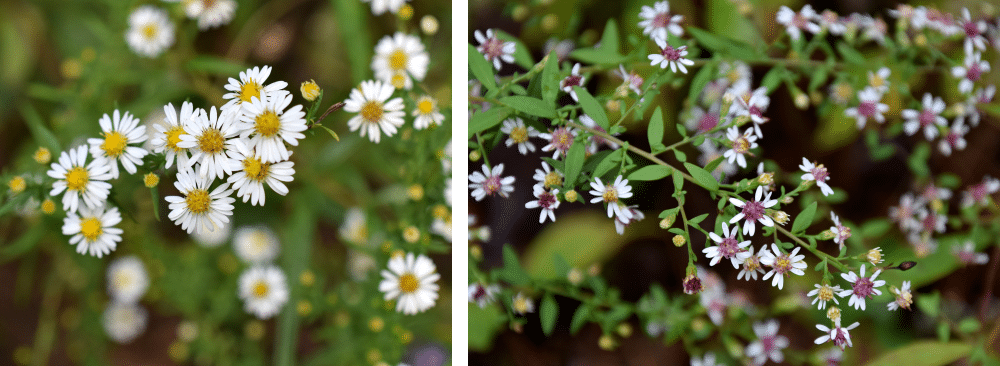Like Helianthus, the subject of last month’s Plant Spotlight, our native asters are also members of the composite family, now called the Asteraceae family. Each aster ‘flower’ is really a flowerhead with tiny disk flowers in the center and showy ray flowers around the edges. Most asters have yellow disk flowers in the center and surrounding white, yellow, or blue/purple ray flowers, all of which produce small seeds. Our beloved Georgia aster (Symphyotrichum georgianum), GNPS Plant of the Year in 2015, is unusual in that it has cream colored disk flowers that age to soft purple – a trait that helps to distinguish it from the similar looking late purple aster (S. patens).
What we commonly call asters are plants spread across a number of genera in North America. Most of the Georgia aster species are in the genus Symphyotrichum but can also be found in Ampelaster, Doellingeria, Eurybia, Oclemena, and Sericocarpus. If you’d like to read more about the 1994 change from Aster to these genera, please see this article.

The white aster group includes (left to right) the smooth oldfield aster (S. racemosum) and the calico aster (S. lateriflorum).
White asters include the well-known white wood aster (Eurybia divaricata), a part-shade, part-evergreen groundcover, 3 species of both Doellingeria and Sericocarpus, two species of Oclemena, as well as the wide-spread roadside asters with numerous small flowers. These roadside asters are an abundant source of late season pollen and nectar for pollinators. They include species with charming and descriptive common names like hairy oldfield aster (Symphyotrichum pilosum), rice button aster (S. dumosum), smooth oldfield aster (S. racemosum), and white heath aster (S. ericoides). In the coastal plain, a couple of others include scaleleaf aster (S. adnatum ) and Walter’s aster (S. walteri). Another common white aster is calico aster (S. lateriflorum), known for the range of colors of the central disk flowers during the flowering period.

Three members of the blue and purple aster group (left to right): Georgia aster (Symphyotrichum georgianum), heartleaf aster (S. cordifolium), and eastern silver aster (S. concolor).
Blue and purple asters are surprisingly abundant as well and include Eurybia species like showy aster (E. spectabilis), creeping aster (E. surculosa), and bigleaf aster (E. macrophylla). Symphyotrichum asters with leaves that clasp the stem include Georgia aster (Symphyotrichum georgianum), late purple aster (S. patens), New England aster (S. novae-angliae), wavyleaf aster (S. undulatum), eastern silver aster (S. concolor), swamp aster (S. puniceum), and smooth blue aster (S. laeve). Others have leaves with non-clasping petioles and they include heartleaf aster (S. cordifolium), Short’s aster (S. shortii), and the coastal marsh aster (S. elliottii).
The goldenasters are another group altogether and were not part of the aster separation of 1994. They include Maryland goldenaster (Chrysopsis mariana), silkgrass (Pityopsis spp., 4 species), and the yellow-flowered camphorweed (Heterotheca subaxillaris).
While I certainly haven’t covered all of the species in Georgia, I hope this gives you a good appreciation for the extensive diversity of the fall beauties that we call Aster. From the mountains to the marshes, in woodlands, fields, and ditches, look for them in wild places, on our plant rescues, and at fall plant sales. But the most important thing is to include them in your garden. Georgia’s pollinators will be very happy that you did, and songbirds get to feast on the seeds all winter.
